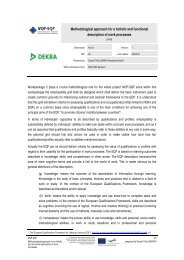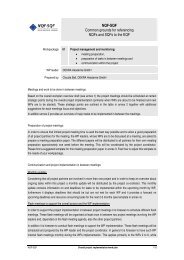Overview of National Qualification frameworks - Project-Nqf-Sqf
Overview of National Qualification frameworks - Project-Nqf-Sqf
Overview of National Qualification frameworks - Project-Nqf-Sqf
Create successful ePaper yourself
Turn your PDF publications into a flip-book with our unique Google optimized e-Paper software.
proposal”. Through the use <strong>of</strong> credits persons with special needs particularly those with mental disability aremotivated to achieve partial qualifications at MQF Levels 1 and 2.Through the use <strong>of</strong> ECTS and ECVET credits there will be more harmonisation in Education in Europe. Users <strong>of</strong>qualifications will be using the same language and the EQF will be functioning as a real bridge between thedifferent education systems across Europe and beyond.__Have you already identified any mislinkings between qualifications within the NQF and the EQF? If so, pleasedescribe briefly?__Which strengths and which weaknesses do you see concerning the NQF? In what way do thesestrengths/weaknesses influence the?In Italy the establishment <strong>of</strong> the NQF is a very important national issue to give individuals a transparent way toobtain qualifications and to progress in their careers. However, it is still very complex and ambitious. The law thatreformed Title V <strong>of</strong> the Constitution (2001) made this process even more complicated in the complexity <strong>of</strong> therelationships between the State and the Regions (some regions are working to establish their own regionalqualifications systems). This reform, combined with the autonomy <strong>of</strong> several stakeholders (autonomy <strong>of</strong> theregional authorities in regulating training; autonomy <strong>of</strong> universities and schools; autonomy <strong>of</strong> the enterprises in<strong>of</strong>fering ‘qualifications’ in the workplace, etc.) created a difficult situation to manage.The stakeholders involved are aware <strong>of</strong> the fundamental importance <strong>of</strong> a national system that should constitutethe ‘real infrastructure’ for different educational and labour market policies.Language differences and use <strong>of</strong> coherent concepts across sectors and stakeholders cause some challenges.Recently introduced education and training reforms gave an indication that Italian VET and HE systems areincreasingly being aligned with the European objectives on transparency and comparability expressed by Bolognaprocess and the EQF.Spain has the following main strengths:__Unification <strong>of</strong> VET system which run previously in 2 ways one ruled by Ministry <strong>of</strong> Education and other ruled byMinistry <strong>of</strong> Labour. Now both are referenced by a Unified national qualification catalogue and recognized eachother qualifications pathways.__Permeability between formal VET education system, VET system ( non formal education) amd UniversitySystem.Main weaknesses:__Central <strong>National</strong> <strong>Qualification</strong> Catalogue update is still slow in relation to changes <strong>of</strong> the labour market andtechnology.__NQF is not integrated in SQF__Homologation and Recognition at University Level is still a lengthy and bureaucracy process.In what way do these strengths/weaknesses influence the referenceability to the EQF?The fact that EQF is already referenced at NQF VET level is a very positive aspect since this part <strong>of</strong> NQF hasbeen implemented quickly on daily educational procedures. However the usage <strong>of</strong> the EQF level itself as amobility tool is rather poor or even inexistent at the moment.As far University level the process is not straightforward yet even among EU countries. This hinders one <strong>of</strong> themain targets <strong>of</strong> EQF: free movement <strong>of</strong> workforce throughout Europe. This hinders also the attraction andpermanence <strong>of</strong> Talent in Europe, which is crucial for Economic Development and have positioning Europe behindUnited States, Canada and Australia."This project has been funded with support from theNQF-SQF:European Commission. This publication reflects the views44/45only <strong>of</strong> the author, and the Commission cannot be held<strong>Overview</strong> <strong>of</strong> <strong>National</strong> <strong>Qualification</strong>responsible for any use which may be made <strong>of</strong> theprepared by 3s research laboratoryinformation contained therein."<strong>frameworks</strong>




